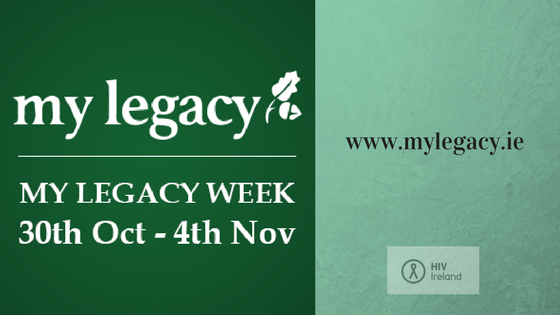In this, our 30th Anniversary year, HIV Ireland is joining together with over 50 charities around Ireland to appeal to the public to leave a legacy gift, large or small, to charity in their will.
Niall Mulligan, Executive Director with HIV Ireland said “When people choose to leave a legacy donation to HIV Ireland they are both supporting our work with people who are living with HIV, and supporting our work in trying to prevent HIV transmission in the first place. We are always extremely grateful for the day to day support we receive from individuals and families across Ireland who care passionately about our work. What many people don’t know is they can also ensure our good work will continue, by leaving a legacy of kindness and support in their will.”
Fergal O’Sullivan, Chairperson of My Legacy said “First and foremost, when you’re making your will, look after your family and loved ones. After that, you might want to consider leaving a legacy gift to a cause you feel strongly about or have an affinity with and you decide what that gift is. Large or small, a charity will appreciate your thoughtfulness and remembrance.”
You can learn more about leaving a gift to charity, and find a local participating solicitor for My Legacy Week online at www.mylegacy.ie
ENDS
For more information please call:
Niall Mulligan,
Executive Director
HIV Ireland
70 Eccles Street
Dublin 7
Mobile: 085 7457951
Tel: 01 8733799
Email: niall.mulligan@hivireland.ie
Notes to Editor
About MyLegacy.ie
My Legacy was established in 2003 by a small group of Irish charities who knew the great impact a legacy gift can have on their work. They know that Irish people tend to put off making a will despite how important a life document it is and how easy it is to do. Since then, My Legacy has grown to an umbrella group of over 50 Irish charities asking people to consider leaving a legacy gift to a charity or cause they feel strongly about, after family and loved ones have been looked after and all other important personal decisions have been made. My Legacy provides unbiased, useful information to individuals, charities and solicitors about leaving legacy gifts to charities. My Legacy does not solicit specific gifts or legacies for individual organisations.
HIV Ireland Information
HIV Ireland is a registered charity operating at local, National and European level. The principal aim of the organisation is to improve, through a range of support services, conditions for people living with HIV and AIDS and/or Hepatitis, their families and their caregivers while further promoting sexual health in the general population.
Our mission and vision is to contribute towards a significant reduction in the incidence and prevalence of HIV in Ireland and towards the realisation of an AIDS-free generation by advocating for individuals living with HIV, preventing new HIV infections and combating HIV-related stigma and discrimination.
Since 1987 HIV Ireland has been pioneering services in sexual health education and promotion, and has consistently engaged in lobbying and campaigning in the promotion of human rights. Our approach broadly reflects a harm minimisation model which emphasises practical rather than idealised goals.


